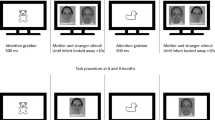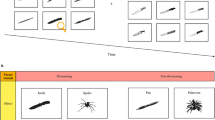Abstract
Attachment-related learning (that is, forming preferences for cues associated with the parent) defies the traditional rules of learning in that it seems to occur independently of apparent reinforcement1—young children prefer cues associated with their parent, regardless of valence (rewarding or aversive), despite the diversity of parenting styles2. This obligatory attraction for parental cues keeps the child nearby and safe to explore the environment; thus, it is critical for survival and sets the foundation for normal human cognitive–emotional behaviour. Here we examined the learning underlying this attraction in preschool-age children. Young children underwent an aversive conditioning procedure either in the parent’s presence or alone. We showed that despite disliking the aversive unconditioned stimulus, children exhibited a behavioural approach for conditioned stimuli that were acquired in the parent’s presence and an avoidance for stimuli acquired in the parent’s absence, an effect that was strongest among those with the lowest cortisol levels. The results suggest that learning systems during early childhood are constructed to permit modification by parental presence.
This is a preview of subscription content, access via your institution
Access options
Access Nature and 54 other Nature Portfolio journals
Get Nature+, our best-value online-access subscription
$29.99 / 30 days
cancel any time
Subscribe to this journal
Receive 12 digital issues and online access to articles
$119.00 per year
only $9.92 per issue
Buy this article
- Purchase on Springer Link
- Instant access to full article PDF
Prices may be subject to local taxes which are calculated during checkout



Similar content being viewed by others
Data availability
The data that support the findings of this study are available from the corresponding author on reasonable request.
Code availability
The code that supports the findings of this study is available from the author on reasonable request.
References
Bowlby, J. Attachment and Loss (Basic Books, 1969).
Rajecki, D. W., Lamb, M. E. & Obmascher, P. Towards a general theory of infantile attachment: a comparative review of aspects of the social bond. Behav. Brain Sci. 3, 417–464 (1978).
Stafleu, A., Van Staveren, W. A., De Graaf, C., Burema, J. & Hautvast, J. G. Family resemblance in beliefs, attitudes and intentions towards consumption of 20 foods; a study among three generations of women. Appetite 25, 201–206 (1995).
Krumhansl, C. L. & Zupnick, J. A. Cascading reminiscence bumps in popular music. Psychol. Sci. 24, 2057–2068 (2013).
Ainsworth, M. D. Object relations, dependency, and attachment: a theoretical review of the infant–mother relationship. Child Dev. 40, 969–1025 (1969).
Moriceau, S. & Sullivan, R. M. Maternal presence serves as a switch between learning fear and attraction in infancy. Nat. Neurosci. 9, 1004–1006 (2006).
Stronach, E. P. et al. Child maltreatment, attachment security, and internal representations of mother and mother–child relationships. Child Maltreat. 16, 137–145 (2011).
Ainsworth, M. D. & Bell, S. M. Attachment, exploration, and separation: illustrated by the behavior of one-year-olds in a strange situation. Child Dev. 41, 49–67 (1970).
Clancy, B., Finlay, B. L., Darlington, R. B. & Anand, K. J. Extrapolating brain development from experimental species to humans. Neurotoxicology 28, 931–937 (2007).
Thompson, J. L. & Nelson, A. J. Middle childhood and modern human origins. Hum. Nat. 22, 249–280 (2011).
Hoffman, K. T., Marvin, R. S., Cooper, G. & Powell, B. Changing toddlers’ and preschoolers’ attachment classifications: the circle of security intervention. J. Consult. Clin. Psychol. 74, 1017–1026 (2006).
Fisher, P. A. & Kim, H. K. Intervention effects on foster preschoolers’ attachment-related behaviors from a randomized trial. Prev. Sci. 8, 161–170 (2007).
Callaghan, B. L. et al. The developmental ecology of fear neurobiology across development. Annu. Rev. Clin. Psychol. 15, 345–369 (2019).
Bailey, D. et al. Marked biological variance in endocrine and biochemical markers in childhood: establishment of pediatric reference intervals using healthy community children from the CALIPER cohort. Clin. Chem. 59, 1393–1405 (2013).
Gee, D. G. et al. A developmental shift from positive to negative connectivity in human amygdala–prefrontal circuitry. J. Neurosci. 33, 4584–4593 (2013).
Silvers, J. A. et al. The transition from childhood to adolescence is marked by a general decrease in amygdala reactivity and an affect-specific ventral-to-dorsal shift in medial prefrontal recruitment. Dev. Cogn. Neurosci. 25, 128–137 (2017).
Hostinar, C. E., Johnson, A. E. & Gunnar, M. R. Parent support is less effective in buffering cortisol stress reactivity for adolescents compared to children. Dev. Sci. 18, 281–297 (2015).
Gee, D. G. et al. Maternal buffering of human amygdala–prefrontal circuitry during childhood but not during adolescence. Psychol. Sci. 25, 2067–2078 (2014).
Callaghan, B. L. et al. Decreased amygdala reactivity to parent cues protects against anxiety following early adversity: an examination across 3 years. Biol. Psychiatry Cogn. Neurosci. Neuroimaging https://doi.org/10.1016/j.bpsc.2019.02.001 (in the press).
Casey, B. J. & Richards, J. E. Sustained visual attention in young infants measured with an adapted version of the visual preference paradigm. Child Dev. 59, 1514–1521 (1988).
Bach, D. R., Flandin, G., Friston, K. J. & Dolan, R. J. Modelling event-related skin conductance responses. Int. J. Psychophysiol. 75, 349–356 (2010).
Flannery, J. E. et al. Diurnal cortisol after early institutional care-age matters. Dev. Cogn. Neurosci. 25, 160–166 (2017).
Vasey, M. W., el-Hag, N. & Daleiden, E. L. Anxiety and the processing of emotionally threatening stimuli: distinctive patterns of selective attention among high- and low-test-anxious children. Child Dev. 67, 1173–1185 (1996).
Raineki, C. et al. Paradoxical neurobehavioral rescue by memories of early-life abuse: the safety signal value of odors learned during abusive attachment. Neuropsychopharmacology 40, 906–914 (2015).
Eisenberg, N., Cumberland, A. & Spinrad, T. L. Parental socialization of emotion. Psychol. Inq. 9, 241–273 (1998).
Sroufe, L. A., Coffino, B. & Carlson, E. A. Conceptualizing the role of early experience: lessons from the minnesota longitudinal study. Dev. Rev. 30, 36–51 (2010).
Campos, J. J. Human Emotions: Their New Importance and Their Role in Social Referencing. Annual Report 1–7 (Research & Clinical Center for Child Development, 1981).
Kernberg, O. F. Early ego integration and object relations. Ann. N. Y. Acad. Sci. 193, 233–247 (1972).
Winnicott, D. W. The theory of the parent-infant relationship. Int. J. Psychoanal. 41, 585–595 (1960).
Baumrind, D. Effects of authoritative parental control on child behavior. Child Dev. 37, 887–907 (1966).
Roth, T. L. & Sullivan, R. M. Consolidation and expression of a shock-induced odor preference in rat pups is facilitated by opioids. Physiol. Behav. 78, 135–142 (2003).
Kertes, D. A. et al. Inhibited temperament and parent emotional availability differentially predict young children’s cortisol responses to novel social and nonsocial events. Dev. Psychobiol. 51, 521–532 (2009).
Schore, A. N. All our sons: the developmental neurobiology and neuroendocrinology of boys at risk. Infant Ment. Health J. 38, 15–52 (2017).
Caldwell, B. M., . & Bradley, R. H. Home Observation for Measurement of the Environment. (University of Arkansas at Little Rock:, 1984).
Baharudin, R. & Luster, T. Factors related to the quality of the home environment and children’s achievement. J. Fam. Issues 19, 375–403 (1998).
Beck, A. T., Steer, R. A., Ball, R. & Ranieri, W. Comparison of Beck depression inventories YIA and YII in psychiatric outpatients. J. Pers. Assess. 67, 588–597 (1996).
Spielberger, C. D. Manual for the State-Trait Anger Expression Inventory. Psychological Assessment Resources (1988).
Coddington, R. D. The significance of life events as etiologic factors in the diseases of children. II. A study of a normal population. J. Psychosom. Res. 16, 205–213 (1972).
Achenbach, T. M. Manual for the Child Behavior Checklist/4-18 and 1991 profile. Department of Psychiatry, University of Vermont (1991).
Rickel, A. U. & Biasatti, L. L. Modification of the block child rearing practices report. J. Clin. Psychol. 38, 129–134 (1982).
Neumann, D. L. & Waters, A. M. The use of an unpleasant sound as an unconditional stimulus in a human aversive Pavlovian conditioning procedure. Biol. Psychol. 73, 175–185 (2006).
Silvers, J. A. et al. Previous Institutionalization is followed by broader amygdala–hippocampal–PFC network connectivity during aversive learning in human development. J. Neurosci. 36, 6420–6430 (2016).
Ham, J. & Tronick, E. A procedure for the measurement of infant skin conductance and its initial validation using clap induced startle. Dev. Psychobiol. 50, 626–631 (2008).
Kirschbaum, C. & Hellhammer, D. H. Salivary cortisol. Encycl. Stress 3, 379–383 (2000).
Watamura, S. E., Donzella, B., Kertes, D. A. & Gunnar, M. R. Developmental changes in baseline cortisol activity in early childhood: relations with napping and effortful control. Dev. Psychobiol. 45, 125–133 (2004).
Sumner, M. M., Bernard, K. & Dozier, M. Young children’s full-day patterns of cortisol production on child care days. Arch. Pedia. Adolesc. Med. 164, 567–571 (2010).
Acknowledgements
This research was supported in part by the Eunice Kennedy Shriver National Institute of Child Health and Human Development Grant R37HD083217 (to R.M.S.) and the National Institute of Mental Health Grant R01MH091864 (to N.T.) The funders had no role in study design, data collection and analysis, decision to publish or preparation of the manuscript. The authors thank A. Galván for her helpful feedback on previous drafts.
Author information
Authors and Affiliations
Contributions
N.T., M.S. and R.M.S. designed the study. N.T., M.S., J.F. and C.C. performed the experiments, data processing and analysis. N.T. and R.M.S. wrote the manuscript and provided overall direction.
Corresponding author
Ethics declarations
Competing interests
The authors declare no competing interests.
Additional information
Peer review information: Primary Handling Editor: Aisha Bradshaw
Publisher’s note: Springer Nature remains neutral with regard to jurisdictional claims in published maps and institutional affiliations.
Supplementary Information
Supplementary Information
Supplementary Methods, Supplementary Results, Supplementary References
Rights and permissions
About this article
Cite this article
Tottenham, N., Shapiro, M., Flannery, J. et al. Parental presence switches avoidance to attraction learning in children. Nat Hum Behav 3, 1070–1077 (2019). https://doi.org/10.1038/s41562-019-0656-9
Received:
Accepted:
Published:
Issue Date:
DOI: https://doi.org/10.1038/s41562-019-0656-9
This article is cited by
-
Life history, love and learning
Nature Human Behaviour (2019)



